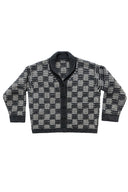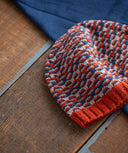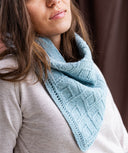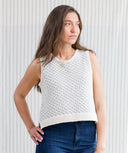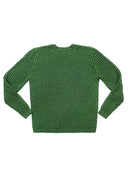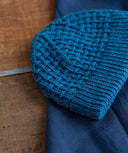Stranded Colorwork 101
Stranded colorwork knitting, recognizable by allover patterning or bands of color motifs, is prominent in many knitting traditions around the world and continues to inspire countless more iterations of creative colorplay today. One of the many reasons we love this technique is that it creates a visually intricate fabric, but is deceivingly simple to work. Stranded colorwork motifs are more often than not worked in the round in plain stockinette, which means that in most cases you simply knit all your stitches while alternating between colors across the round.
Colorwork motifs are often presented in charts, as this is an intuitive and shorthand way of showing how the motif builds round by round. Unlike charts for lace or cabled patterns, which will require you to be familiar with a number of chart symbols, all you’ll need to keep in mind when following a colorwork chart are the colors of the boxes. (We found that for this reason, colorwork charts are quite helpful for learning how to read knitting charts.)
For example, in Round 1 of the colorwork chart below (adapted from the Lucerne pattern), the first stitch is worked in C1, the next in C2, and the following two stitches are worked in C1.

Managing Float Tension
Unlike other types of colorwork knitting techniques (such as striping or intarsia), stranded colorwork requires you to carry along the strand of yarn not in use across the back of the work. In other words, when you alternate between colors of yarn, the previously unused strand travels behind the stitches just worked until it is ready to be used again, resulting in a horizontal strand on the wrong side (WS). Stranded colorwork knitting is referred to as such because of these strands (or floats) left on the inside of your work.

One thing that is important to keep in mind in stranded colorwork knitting is maintaining even float tension. Because knitted fabric is elastic, the floats traveling behind worked stitches must be long enough to span the width of those stitches, both when stretched and relaxed. If the floats are too tight, they will draw your fabric in, causing puckering which will change the look and fit of your finished item. If the floats are too loose, they can get caught when you wear the garment or the stitches may recede in the background.
There are a number of ways to manage the tension of your floats. One way is to go up a needle size when working colorwork (but do swatch to make sure your gauge remains accurate to the pattern you’re following!) — often, it is not uncommon for knitters to knit stranded colorwork with a tighter than usual tension, due to the mechanics of alternating between multiple working yarns. Going up a needles size can help compensate for this tighter tension.
It is also helpful to spread out the stitches just worked on the right needle each time you switch yarns or colors, so that when you draw the next working yarn (C1) behind the stitches just worked in the previous (C2), you can be sure that its float can span the full width of the stitches just worked.
The method you use to strand your working yarns may also have different effects on your tension. Some knitters find that it is easier for them to achieve an even tension when they hold the different yarns in either hand (C1 on the right and C2 on the left, for example), while some find it easier when they hold both yarns in the same hand.
In the words of June Hemmons Hiatt, the most successful method “is as much a matter of anatomy as it is of dexterity,” so keep swatching, experimenting, and practicing to find what works best for you.
The Importance of Color Dominance

When working stranded fabric with two or more colors, one color (the Dominant Color) will always be more prominent on the right side (RS) while the other (the Background Color) recedes to the background. This effect is referred to as color dominance and is a result of how the yarns are stranded in relationship to one another on the WS of the fabric as you work. To accompany the colorwork charts in our patterns, we provide a key showing which colors should be held as the Dominant Color and the Background Color.
Regardless of how you hold your yarns when working stranded colorwork, the float of the Dominant Color should always be stranded below the Background Color. If you hold one color in each hand, the easiest way to manage color dominance is to hold the Dominant Color in your left hand and strand it below the Background Color on the WS of the fabric. And vice versa — hold the Background Color in your right hand and strand it above the Dominant Color on the WS of the fabric.

Keeping your Dominant Color and Background Color consistent will ensure that your colorwork motifs “pop” rather than recede into the background. Notice how in the Peerie swatch above (left), the Dominant Color stitches in Hammock are bigger and stand out amidst the Background Color stitches in Nori. When flipped to be a Background Color (right), these Hammock stitches become smaller and less distinct.
Swatching for Success
We believe swatching is an important part of the process of beginning any project. For stranded colorwork knitting in particular, swatching may be even more invaluable, as it allows for the opportunity to practice stranding techniques, get acquainted with the mechanics of working with multiple strands of yarn, and test color combinations before committing to a larger project.
To swatch for a stranded colorwork motif, we recommend the Speed Swatching method for circular knitting; because most stranded colorwork patterns are worked in the round, it is best to swatch in the round as well. Follow the instructions in the Swatching for Circular Knitting section of our Swatching 101 article to learn more.
In Conclusion
If you're unsure about what patterns to start with, we recommend the following form our Pattern Database (from left to right): Lucerne, Morse, Seeds, and Sommers. These patterns are particularly well-suited for practicing stranded colorwork as they're smaller projects, worked in the round, and feature motifs that don't require working with more than two strands or colors of yarn in the same round. Equipped with the basics of stranded colorwork knitting, you can now proceed with confidence!

